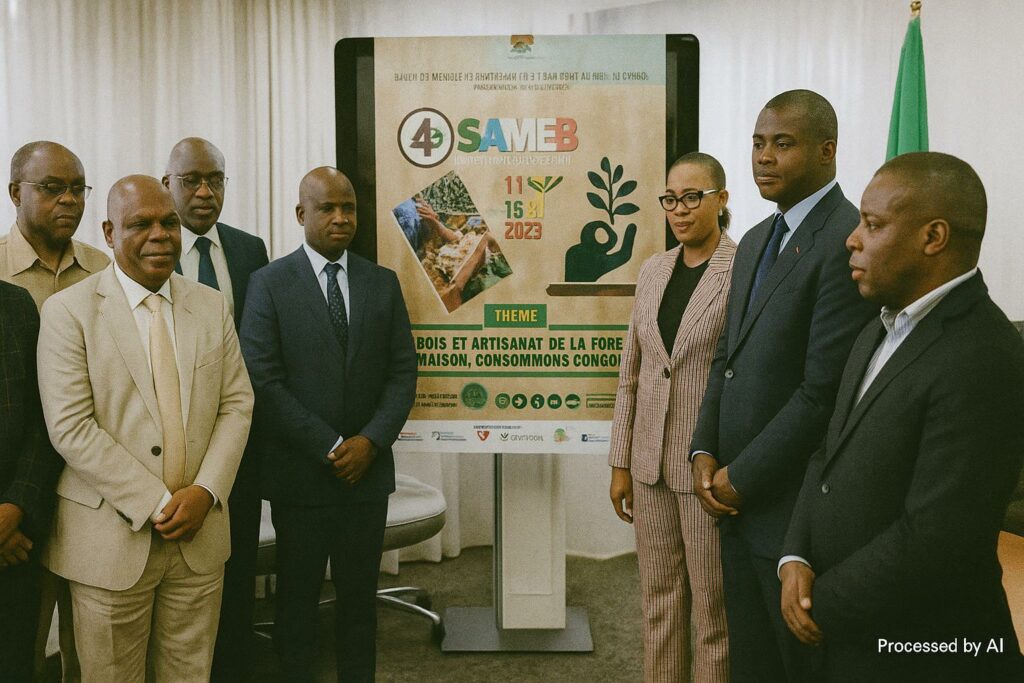Brazzaville prepares a showroom for Congolese timber art
Each August, the banks of the Congo River swell with equatorial humidity and diplomatic expectations alike. From 11 to 25 August, the fourth Salon des métiers du bois—popularly abbreviated Sameb—will convert Brazzaville’s exhibition grounds into a living gallery of Congolese woodcraft. By placing the slogan “Bois et artisanat : de la forêt à la maison, consommons congolais” at the centre of its branding, organisers appeal to a double ambition: revitalising an artisanal tradition and inserting it more firmly in national consumption patterns. Minister of Small and Medium-Sized Enterprises and Handicrafts Jacqueline Lydia Mikolo framed the gathering as “an invitation to value the made-in-Congo label”, noting that similar pieces often cross borders before returning to domestic shelves at a premium. Her call hints at an under-exploited market sitting inside Congo’s own frontiers.
From workshops to the marketplace: Sameb’s operational logic
Sameb functions as more than a trade fair; it is conceived as a bridge between remote ateliers in Ouesso or Dolisie and the urban purchasing power of Brazzaville’s middle class. Carpenters, sculptors and basket-weavers who usually rely on informal networks will gain the visibility of formal exhibition stands, professional matchmaking sessions and training seminars co-facilitated by the Ministry of Forest Economy. These platforms are designed to compress the journey from raw log to finished household object, demonstrating to visitors that value addition need not be outsourced. According to data shared by the national Chamber of Trades, less than thirty percent of locally felled timber is processed domestically, leaving a sizeable margin for import substitution.
Anchoring craft production to the diversification agenda
Congo-Brazzaville’s National Development Plan assigns a pivotal role to non-oil sectors in cushioning commodity volatility. Wood, the country’s second-largest export by volume, has long been dominated by primary log shipments. Sameb reframes the resource as an engine of small-scale industrialisation, compatible with the government’s objective to raise the share of manufactured goods to twenty percent of GDP by 2030. In her media briefing, Minister Mikolo underscored that artisanal value chains are inherently employment-intensive, pointing to a study by the African Development Bank that every million dollars invested in craft industries creates twice as many jobs as in extractive activities. The fair thus embodies a policy experiment: can a cultural asset convert into macroeconomic resilience without forfeiting ecological safeguards?
Regional diplomacy and South–South commercial synergies
Previous Sameb editions attracted delegations from Rabat to Windhoek, and this year’s guest list again reads like a map of South-South commercial aspirations. Morocco, Angola, Namibia and the Democratic Republic of Congo have confirmed participation, bringing not only exhibition pieces but procurement officers scouting joint ventures in drying kilns, eco-certification and design schools. The Ministry of Foreign Affairs quietly views the fair as a soft-power corridor, one where handshake deals on the show floor may later mature into cross-border industrial parks. A senior diplomat, requesting anonymity because negotiations are ongoing, described Sameb as “a boutique Davos for timber nations,” where commercial discussions unfold in a politically relaxed setting far from formal summitry.
Nurturing a culture of local consumption
Sceptics observe that the exhortation to “consume Congolese” has been voiced before, yet imported furniture continues to dominate urban homes. Minister Mikolo concedes the challenge, attributing it less to patriotism than to distribution gaps. Many artisans remain outside digital commerce and standardised packaging, limiting their reach to walk-in customers. Sameb tries to close this gap through e-catalogues, live‐streamed auctions and partnerships with fintech start-ups offering micro-payment solutions. Pierre Obambi, a third-generation cabinet-maker from Pointe-Noire, claims that last year’s fair tripled his order book within two weeks. “Clients discovered we could tailor to their dimensions in half the time an overseas order needs,” he explains, adding that lower logistics costs translate into consumer savings.
Environmental stewardship within a heritage industry
Congo’s forest mass remains the world’s second-largest tropical carbon sink. Any initiative that intensifies wood utilisation faces scrutiny from conservation circles. Organisers respond by foregrounding artisanal production’s minimal waste footprint and by partnering with the Forest Stewardship Council to conduct on-site awareness sessions. A pilot project with the French Development Agency finances solar-powered kilns that reduce reliance on diesel generators. These steps seek to demonstrate that artisan-driven value addition can coexist with the country’s commitments under the Central African Forest Initiative.
An inflection point for artisan-led development
Whether Sameb can translate festival momentum into year-round market dynamics will hinge on credit access, standards certification and consumer perception. Yet the 2023 edition arrives at a favorable geopolitical juncture marked by renewed interest in African creative industries. As Minister Mikolo reiterated during her briefing, “the best does not always come from elsewhere.” By intertwining heritage, employment and diplomacy, Sameb offers a measured but tangible pathway toward the broader vision of an economy less dependent on hydrocarbons and more reflective of Congolese craftsmanship.

